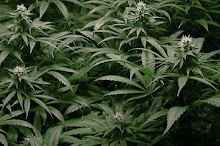21 September 2010
Hemp License In Eastern Kentucky
compiled by Teresa Martin Klaiber
September 2010
Hemp was needed for ropes and used in feed bags and bailing twine. Early Kentucky pioneers brought the seed from Virginia and set aside acres for production. Lewis Collins cited Nathan Burrows of Lexington as being the first to introduce the manufacture of hemp into Kentucky about 1796 [Historical Sketches of Kentucky].
James Klotter's New History of Kentucky references eighteen rope and bagging manufacturers in Fayette County during 1838. By 1890 the Commonwealth was producing 94% of all the hemp produced in the United States.
Both Klotter and John Kleber, author of The Kentucky Encyclopedia, concentrate on larger production in central Kentucky. But it was James F. Hopkins, at the University of Kentucky who realized the historical significance that the production of hemp played within the Commonwealth. While working on his master's in 1936, he concentrated on the relevance of cultivation, processing and marketing relative to Kentucky's social, economic and even political history. His book A History of the Hemp Industry In Kentucky is still available today.
As a baby boomer and a young adult of the 60's our generation's idea and thoughts of hemp was in the form of marijuana known as "pot" and "weed" and smoked at Woodstock. And while today helicopters do regular scans of Eastern Kentucky for marijuana fields I either was very naive or it did not exist in Boyd County when I was in high school.
Thus I was intrigued to learn more about the history of hemp when I discovered that it had been grown and hempseed sold legally from the farm we own.
The effects of cannabis came to national attention in the late 1910's. The Uniform State Narcotic Act was finalized in 1932. But just prior to World War II fiber and jute production was on the rise. Strict controls were imposed on the raising and selling of the seed and hemp. Licenses were issued by the federal government and only a very strict few obtained them. According to the forward in Hopkins book the licenses "became little more than bragging curiosities, and the end of the war rang down the historic curtain on that second modest phase of hemp growing in Kentucky."
I take offense on behalf of my father-in-law about bragging rights. I know what a hard working proud Eastern Kentucky farmer he was. Every inch of dirt on this farm was utilized as was every crop to produce a living to put food on the table. He would not have wasted acres nor the trouble it must have been to acquire the license if it were not going to have a monetary value for the family.
The U. S. Department of Agriculture assigned each farm a number [they still do today]. John H. Klaiber received license 8107 pursuant to the Marihuana Tax Act of 1937. It gave him the right to own hempseed and the legal right to sell it. The seed had to be cleaned with a combine or hand fan cleaning mill. The prices were set by the Commodity Credit Corporation and was sold directly to them. 
Reading the fine print on the surviving contract, John H. Klaiber had for 1943, the seed had to be cleaned so that morning glory seed or other foreign matter was less than 2%. Klaiber turned in 5.27 bushels. After testing he received $36.37 for his efforts in this early 1943 contract.
According to a USDA publication titled Industrial Hemp in the United States during World War II imports of abaca and jute were unavailable. the Government instituted this emergency program to produce hemp as a domestic substitute. The Commodity credit Corporation contracted with War Hemp Industries, Inc. which was a "quasi-official organization." The production peaked in 1943 which is the year we have the farm license. As soon as the war was over legal restrictions were reimposed though one small hemp fiber industry continued in Wisconsin until 1958.
The USDA produced a film in 1942 titled Hemp For Victory to encourage farmers to grow it as part of the war efforts. The goal for 1943 was 50,000 acres of seed hemp and the target area was Kentucky. Thanks to the Hemp Industries Association the link at the film title in this blog will provide readers with a transcript of the campaign to get farmers to grow the product.
Posted by tklaiber at 3:46 PM ![]()




can i obtain a license and start growing hemp, i live in northern Kentucky, and where would i begin
ReplyDelete